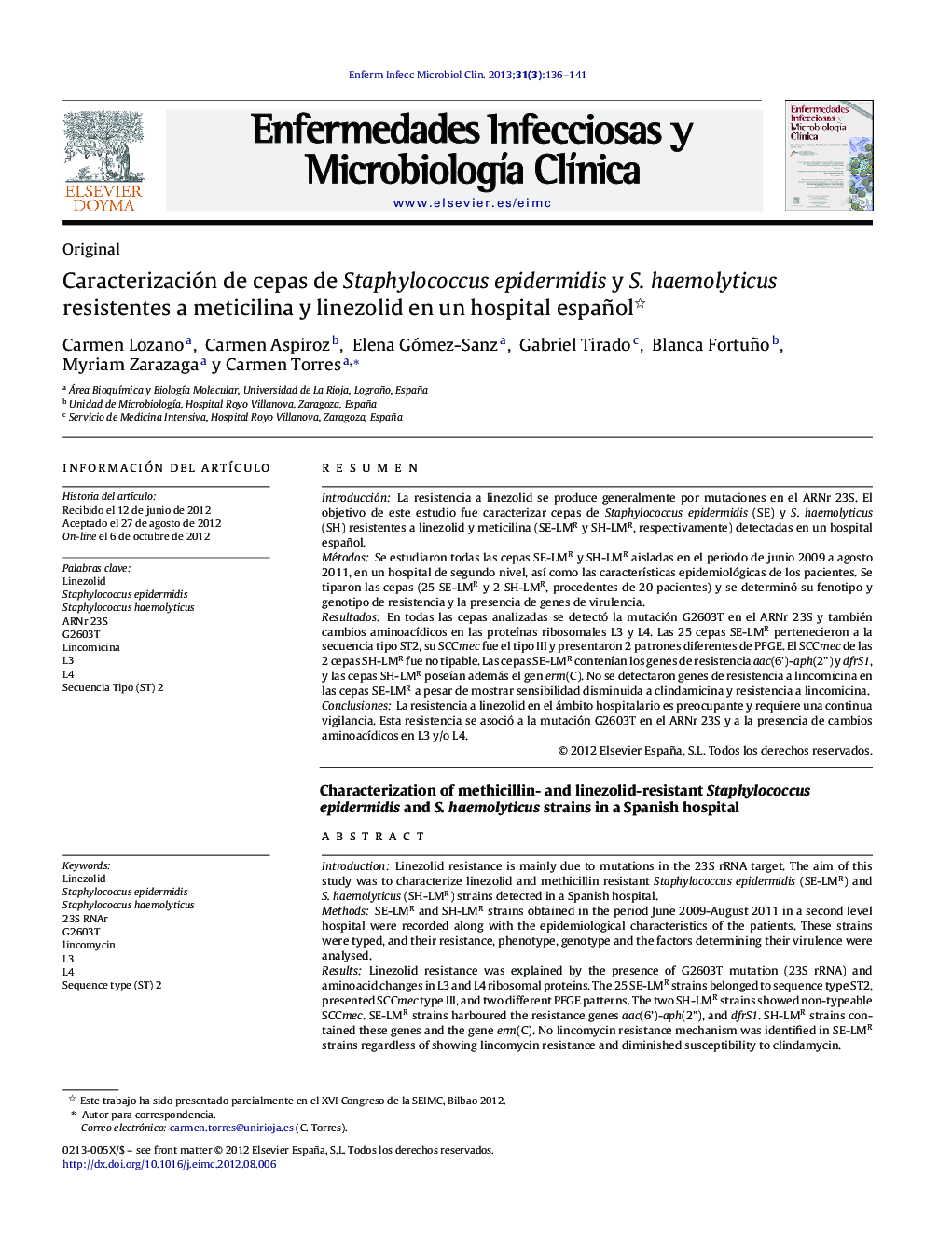| کد مقاله | کد نشریه | سال انتشار | مقاله انگلیسی | نسخه تمام متن |
|---|---|---|---|---|
| 3401281 | 1222657 | 2013 | 6 صفحه PDF | دانلود رایگان |

ResumenIntroducciónLa resistencia a linezolid se produce generalmente por mutaciones en el ARNr 23S. El objetivo de este estudio fue caracterizar cepas de Staphylococcus epidermidis (SE) y S. haemolyticus (SH) resistentes a linezolid y meticilina (SE-LMR y SH-LMR, respectivamente) detectadas en un hospital español.MétodosSe estudiaron todas las cepas SE-LMR y SH-LMR aisladas en el periodo de junio 2009 a agosto 2011, en un hospital de segundo nivel, así como las características epidemiológicas de los pacientes. Se tiparon las cepas (25 SE-LMR y 2 SH-LMR, procedentes de 20 pacientes) y se determinó su fenotipo y genotipo de resistencia y la presencia de genes de virulencia.ResultadosEn todas las cepas analizadas se detectó la mutación G2603T en el ARNr 23S y también cambios aminoacídicos en las proteínas ribosomales L3 y L4. Las 25 cepas SE-LMR pertenecieron a la secuencia tipo ST2, su SCCmec fue el tipo III y presentaron 2 patrones diferentes de PFGE. El SCCmec de las 2 cepas SH-LMR fue no tipable. Las cepas SE-LMR contenían los genes de resistencia aac(6’)-aph(2”) y dfrS1, y las cepas SH-LMR poseían además el gen erm(C). No se detectaron genes de resistencia a lincomicina en las cepas SE-LMR a pesar de mostrar sensibilidad disminuida a clindamicina y resistencia a lincomicina.ConclusionesLa resistencia a linezolid en el ámbito hospitalario es preocupante y requiere una continua vigilancia. Esta resistencia se asoció a la mutación G2603T en el ARNr 23S y a la presencia de cambios aminoacídicos en L3 y/o L4.
IntroductionLinezolid resistance is mainly due to mutations in the 23S rRNA target. The aim of this study was to characterize linezolid and methicillin resistant Staphylococcus epidermidis (SE-LMR) and S. haemolyticus (SH-LMR) strains detected in a Spanish hospital.MethodsSE-LMR and SH-LMR strains obtained in the period June 2009-August 2011 in a second level hospital were recorded along with the epidemiological characteristics of the patients. These strains were typed, and their resistance, phenotype, genotype and the factors determining their virulence were analysed.ResultsLinezolid resistance was explained by the presence of G2603T mutation (23S rRNA) and aminoacid changes in L3 and L4 ribosomal proteins. The 25 SE-LMR strains belonged to sequence type ST2, presented SCCmec type III, and two different PFGE patterns. The two SH-LMR strains showed non-typeable SCCmec. SE-LMR strains harboured the resistance genes aac(6’)-aph(2”), and dfrS1. SH-LMR strains contained these genes and the gene erm(C). No lincomycin resistance mechanism was identified in SE-LMR strains regardless of showing lincomycin resistance and diminished susceptibility to clindamycin.ConclusionsLinezolid resistance is of concern in hospitals, and requires continued vigilance. Several linezolid resistance mechanisms (mutation in 23S RNAr and amino acid changes in L3 and L4) were identified in this study.
Journal: Enfermedades Infecciosas y Microbiología Clínica - Volume 31, Issue 3, March 2013, Pages 136–141